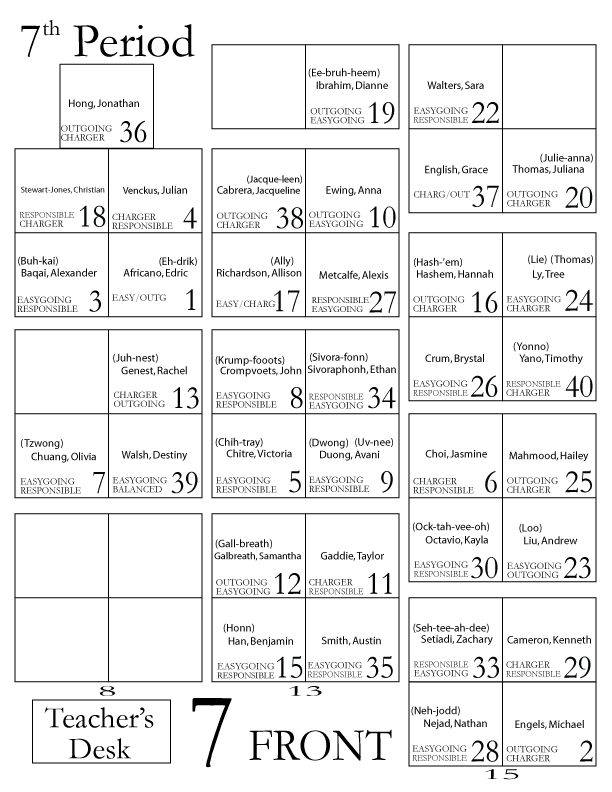 Throughout human history and pretty much every teacher’s first weeks of school, names have been powerful things. Even mystical. In ancient societies, it was believed that if you knew someone’s name you had a special power or command over them. Especially if they were a diety! So people would try to know the gods’ names to get them to do what they wanted, and the gods (of course) would lie about their names to keep from being controlled.
Throughout human history and pretty much every teacher’s first weeks of school, names have been powerful things. Even mystical. In ancient societies, it was believed that if you knew someone’s name you had a special power or command over them. Especially if they were a diety! So people would try to know the gods’ names to get them to do what they wanted, and the gods (of course) would lie about their names to keep from being controlled.Every substitute teacher knows this battle too.
“Hey you,” the teacher says.
“Who me?” the bad bad student says.
“What’s your name?”
Awkward pause. Then the student says, “Mike.”
“All right, Mike, you are clearly not listening, so I’m writing your name on the teacher’s list and you’ll have to deal with her when she returns.”
Then you notice a couple of snickers on student faces. And a hard-to-hide smirk on Michael’s lips.
He’s pulled a fast one on you. Maybe you can’t prove it, but gosh if you didn’t wish you knew his name!!!
This coming school year will be my 13th year teaching (middle school, high school, college, and subbing), and one thing I’ve started making a HUGE COMMITMENT to do is learn my students’ names. And I think it’s one of the most important things I do as a teacher. I believe this so strongly. I learn all of their names. All of them. Even the students who all look alike. Even the names that are super difficult to say.
Now this is one area where Elementary teachers have it easy. 20-30 names. Easy. Try 6 or 7 classes of 30-40 names! Last year my middle school English classes had 250+ students, which = 250+ names. How on God’s green Earth is a teacher supposed to learn all those?! Should we even put that pressure on ourselves. After all those first couple weeks of school are stressful enough already! The answer is yes. It is worth it. Even when it’s difficult.
 Because students can see feel through the bull crap. We’ve got these awesome classroom rules about respect and all that, yet when we call on the student we say, “Hey you!” Hey you? We know when someone values and respects us, especially when it’s a teacher we’re going to be with all year long. Let’s show them the respect they deserve. Unconditional respect. This means we respect them because they’re a human, not because of their behavior (look for a blog post on this in the future).
Because students can see feel through the bull crap. We’ve got these awesome classroom rules about respect and all that, yet when we call on the student we say, “Hey you!” Hey you? We know when someone values and respects us, especially when it’s a teacher we’re going to be with all year long. Let’s show them the respect they deserve. Unconditional respect. This means we respect them because they’re a human, not because of their behavior (look for a blog post on this in the future). It will help us realize again, year after year, that our cultural heritage (whatever one that is) is not the most important or any better than our students’. Just because our culture’s perennial name winners are easy for us to say does not make them better names…it just makes them more familiar. So let’s broaden our cultural horizons. Let’s learn to speak other cultures. And correctly! Don’t just half-effort the names. Have the kid repeat it until she’s happy with your pronunciation. Then write down some phonetic reminder of how to say it.
It will help us realize again, year after year, that our cultural heritage (whatever one that is) is not the most important or any better than our students’. Just because our culture’s perennial name winners are easy for us to say does not make them better names…it just makes them more familiar. So let’s broaden our cultural horizons. Let’s learn to speak other cultures. And correctly! Don’t just half-effort the names. Have the kid repeat it until she’s happy with your pronunciation. Then write down some phonetic reminder of how to say it.So our seating charts might look something like this (student names changed for privacy reasons):
NOTE: Those words at the bottom (Charger, Responsible, Easygoing, Outgoing) are from a personality profile I have my students do. It’s from the book Seriously Dating and Engaged by Becky Tirabassi. We don’t have permission to publish the personality profile, but there are so many available out there. We highly recommend learning your students personalities (another blog post in the future).
NOTE #2: Those numbers in the boxes are their classroom textbook numbers.
NOTE #3: Those numbers at the front of each row pairs are the number of students in those rows to make counting handouts fast and easy.
 When we use their actual names, it instantly makes the environment more personal. They can feel that you’ve already tried to KNOW them. Because you have. It’s hard to learn people’s names, and when their teacher puts in the effort, they feel safer, like they belong. What a great feeling to give our students. This will also prime the pump for our students to open up later throughout the year, even sharing some personal thoughts, beliefs, feelings, fears while we read novels or discuss non-fiction. They might even get enough courage to discuss or argue or debate. Woot!
When we use their actual names, it instantly makes the environment more personal. They can feel that you’ve already tried to KNOW them. Because you have. It’s hard to learn people’s names, and when their teacher puts in the effort, they feel safer, like they belong. What a great feeling to give our students. This will also prime the pump for our students to open up later throughout the year, even sharing some personal thoughts, beliefs, feelings, fears while we read novels or discuss non-fiction. They might even get enough courage to discuss or argue or debate. Woot!
 Which will lead to deeper involvement. By all the students. Not just the ones…wait for it…that we know their names. 🙂 Because the way it normally works is that the naturally outgoing students speak up, get their names known, and get more attention all year long because they started their own “know”ing process and so did the teacher. When we learn all of their names, even the easygoing, responsibly quiet students will feel the buy-in to participate. They’ll feel included.
Which will lead to deeper involvement. By all the students. Not just the ones…wait for it…that we know their names. 🙂 Because the way it normally works is that the naturally outgoing students speak up, get their names known, and get more attention all year long because they started their own “know”ing process and so did the teacher. When we learn all of their names, even the easygoing, responsibly quiet students will feel the buy-in to participate. They’ll feel included. Students are shy. I know, some aren’t, but most are. They pick a corner of the room and sit there most of the year. Which means they hardly ever meet each other, especially not those kids that chose the far aisle during the first week of school. When we use their full names, it not only introduces our students to the equally respected variety of cultures, but it helps connect them to each other. Let’s help them with that. As hard as it may be.
Students are shy. I know, some aren’t, but most are. They pick a corner of the room and sit there most of the year. Which means they hardly ever meet each other, especially not those kids that chose the far aisle during the first week of school. When we use their full names, it not only introduces our students to the equally respected variety of cultures, but it helps connect them to each other. Let’s help them with that. As hard as it may be. That’s right…street cred. Word of mouth spreads. Students aren’t dumb. They can tell which teachers really care, and they are more than happy to reciprocate. Remember Reason #2? Some of us want the students to respect us first before we’ll respect them. The opposite is actually the best way to go. Respect them first, no matter what. It may take them a while, but they’ll pick up on it. Or maybe their peers will figure it out first, then when Chucklehead from 3rd Period tries to badmouth you out during Nutrition, the students will actually defend you. Word will spread. Then this crazy phenomenon will happen: your students will start respecting you back. Then next year will start out easier than this year did. Street cred lives on from year to year.
That’s right…street cred. Word of mouth spreads. Students aren’t dumb. They can tell which teachers really care, and they are more than happy to reciprocate. Remember Reason #2? Some of us want the students to respect us first before we’ll respect them. The opposite is actually the best way to go. Respect them first, no matter what. It may take them a while, but they’ll pick up on it. Or maybe their peers will figure it out first, then when Chucklehead from 3rd Period tries to badmouth you out during Nutrition, the students will actually defend you. Word will spread. Then this crazy phenomenon will happen: your students will start respecting you back. Then next year will start out easier than this year did. Street cred lives on from year to year.














